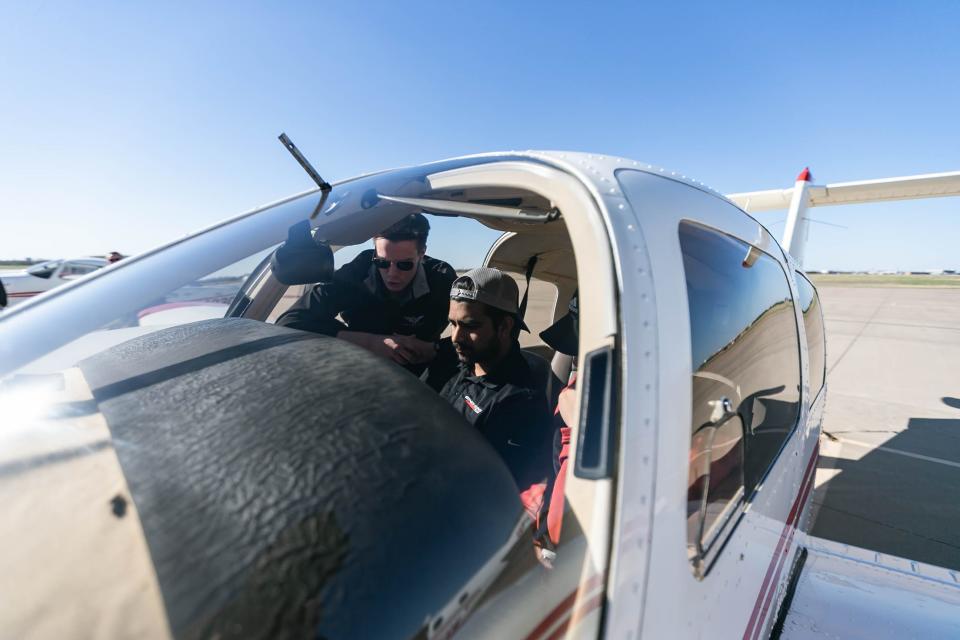Oklahoma's aerospace industry struggles with labor shortage

- Oops!Something went wrong.Please try again later.
Oklahoma is tied for fifth lowest unemployment rate in the country, a signal that there are more open jobs than there are people to fill them.
It's been a continued reality in Oklahoma as the state has seen its employment rate return to normal post-pandemic outbreak, but employers in many industries continue to struggle with labor shortages. Restaurants have had well-documented struggles finding servers and wait staff, and the pandemic has battered employers needing to hire in the healthcare and transportation fields.
Oklahoma recovered nearly 79% of the jobs lost in early 2020, according to an analysis by USA Today, an indication of a near-return to pre-pandemic labor market levels.
More: Democrats accuse oil companies of 'ripping off the American people' on gas prices

But a job category that continues to see perhaps one of the most significant labor shortages is engineering. It's an essential skill for the aerospace industry, which is one of Oklahoma's core economic drivers and the focus of considerable development effort by the Commerce Department and Gov. Kevin Stitt.
Despite that, there is an imbalance between available jobs and available workers. For example, said Geoff Camp, director of aerospace and defense at Commerce, operations at Tinker Air Force Base needs more engineers than the state can provide.
"And that's just Tinker without Boeing and Northrop (Grumman). We haven't even started talking about American Airlines," Camp told The Oklahoman. "That's kind of what we're up against. It's an arms race for engineers."
In late March, Boeing's Oklahoma City facility had nearly 200 unfilled positions. Most were engineering jobs that require years of academic study. The Oklahoma City Air Logistics Complex at Tinker has 110 positions it can't fill. And Kratos Defense, which is vying to produce a line of autonomous fighter aircraft for the U.S. Air Force, is looking to hire two dozen employees.
But unfortunately for employers here, demand is also high across the country, said James Grimsley, executive director of advanced technology initiatives at the Choctaw Nation of Oklahoma.
More: New law blocks plans for Crossroads Mall marijuana farm on same site as school
"There's a STEM shortage," he said, referring to graduates of a diverse group of academic disciplines that include science, technology, engineering and math. "And a lot of the bigger companies are sort of desperate because they would love to work with universities to incentivize universities to produce more."
It's not just the large legacy companies, either. Skydweller Aero, which moved its headquarters to Oklahoma two years ago, is developing strong ties with state universities to prepare the next generation of an aerospace workforce.
"That's helped us create a little pipeline with the schools and getting their top-of-class graduates in master's programs and undergrad programs," said Joey Jayachandran, Skydweller's vice president of U.S. operations.
In a statement, Boeing said the aerospace and defense industry is experiencing the same challenges as the rest of the labor market and is competing to hire the best talent. Boeing has about 3,500 employees in Oklahoma who support programs for bomber, surveillance and "head of state" aircraft.
Even if Oklahoma produces more aerospace engineers and similarly educated graduates in mechanical and computer engineering, it still has to compete with other states.
"Oklahoma really seems to be growing quite well and modernizing as a state, at least in the population centers. And that attracts some of those people who left to go to California, New York and other places," Jayachandran said.
More: Gov. Stitt thinks this small, Oklahoma town is set to boom. Here's why he might be right
There's real danger in not producing or recruiting enough workers to fill high-skill jobs, said Grimsley. Companies looking for a place to plant roots are more likely to shy away from states that can't meet their needs.
It also can be more expensive for companies that have to compete with each other to hire the best talent.
"It's a good time to be an engineer. It may not be a great time to hire engineers because you have a small pool (to choose from)," Grimsley said.
He said Oklahoma should focus on extending the pipeline even earlier than from college, exposing students before high school to opportunities for those who follow the STEM path. Grimsley also noted the continued lack of gender diversity within STEM occupations.
"We need more young girls to be aware that this is something that could be great career opportunities for them," he said. "They're capable of it and we need to build that confidence early."
Staff writer Dale Denwalt covers Oklahoma's economy and business news for The Oklahoman. Have a story idea for Dale? He can be reached at ddenwalt@oklahoman.com or on Twitter at @denwalt. Support Dale’s work and that of other Oklahoman journalists by purchasing a digital subscription today at subscribe.oklahoman.com.
This article originally appeared on Oklahoman: Oklahoma's aerospace industry struggles with labor shortage

